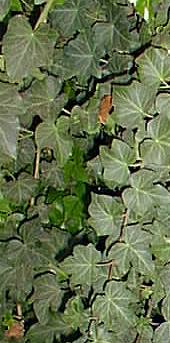Sunset®: 3-34, 39
USDA: 6-10
Frost Tolerance: Hardy
Heat Tolerance: Resistant if not exposed to any direct sunlight
Sun Exposure: Shade in Phoenix
Origin: Europe
Growth Habits: Evergreen vine, or ground cover. 6-8 inches high as ground cover (15-20 cm), up to 50 feet tall as vine (15 m). Clings to brick or masonry.
Flowers: White or greenish flowers
Watering Needs: Drought resistant, does better with regular water
Propagation: Cuttings, marcotting
The English Ivy can be difficult to start in Phoenix. It needs a cooler area, like a north or east wall, a lot of shade, and a lot of water to get established. Once established, deep watering twice a month (like SRP irrigation) will keep it satisfied. If it is in a satisfying location, and get enough water, it might get invasive, and is difficult to remove from the walls. It is also prone to climb on trees, and although it is not a parasite, its weight and bulk can seriously weaken the tree. It is considered a pest in a number of states of the USA.
Blooming Habits:
The flowers, seldom noticed, are tiny and greenish, in round clusters. They are followed by 0.25 inches (6 mm) black berries.
Culture:
Do better in moist soil with good organic content. Plant in fall (warm climates) or spring, 12 to 24 inches apart. Trim in the fall, if used as ground cover, shear it in early spring, so that the new growth covers rapidly the naked areas. Although they seldom attack it, slugs and snails love the environment under ivy leaves. Treat occasionally to prevent them to attack the rest of your garden from this hidden lair.
Propagation:
Spider mites can be a problem if the foliage stays dry and dusty. Copiously soaking the foliage on a regular base is generally enough to avoid the problem. In other areas than Phoenix, fungal diseases can be a problem.
Desert-Tropicals is dedicated to provide gardening advice, gardening ideas, and information about flower of all kind for landscape and collections.We try to check carefully the identification of the plants on the illustrations as well as the other information from the page, but occasionally errors do occur. if you notice anything that needs to be changed please contact us.Thanks.
© 1998-2020 Philippe Faucon, All Rights Reserved.
